Recent trends in the prices of compound feeds
Prices of aquafeed for indicator species in Asia and western Europe
Moreover, current use of aquafeed in terms of quantities and predictions for future requirements are given in Table 20. Some feed and ingredient prices are given in Tables 21 and 22. As a result of the intensification of fish farming and the introduction of new species in aquaculture there tends to be more
dependency on commercially manufactured compound feeds. Manufactured compound aquafeed prices vary from a few hundred dollars to over US$1000/tonne depending on the species being fed. Aquafeeds for high-value and carnivorous species are in the higher price range. Farmers may be constrained from using commercial compound aquafeeds when prices of certain high-value species (see Section 1.4) fall and other
freshwater fish species fetch low prices in the process of intensifying culture practices. Moreover, aquafeed prices, especially that of commercial compound aquafeeds, may increase from their current level due to increasing prices of ingredients (Table 23) and shortfalls in local supplies. This situation compels the users to import feeds. Commercial feed prices of shrimp in Indonesia increased by US$50/tonne during 2005
because of escalating prices of ingredients (Nur, 2007). Weimin and Mengqing (2007) estimated that in China there will be a shortfall of 43.2 million tonnes of cereals and 25.2 million tonnes of protein sources to meet the estimated demand of aquafeeds by 2015. This indicates that China will remain a net importer of ingredients to meet its aquafeed demand, contributing to high prices of ingredients on the world market. It has been reported that the feed manufacturing industry suffered from a perennial shortage of key ingredients such as fishmeal and soybean meal (AFSDBAI, 2005).
Depreciation of local currencies against the United States dollar will further increase the import cost of feed ingredients. For example, 70-90 percent of the feed cost of tilapia (US$236309/tonne) in the Philippines in 2003 was attributed to imported feed ingredients (Sumagaysay-Chavoso, 2007). About 10 000 tonnes of fishmeal is imported
into Thailand annually; there is a shortfall of soybean production of 1.68 million tonnes to meet the demands of the feed industry (Thongrod, 2007).
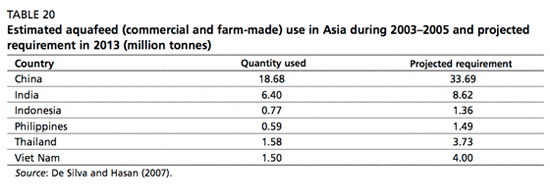

Volatility in commodity prices and underlying reasons
Fishmeal and fish oilFishmeal is a meal produced after cooking, pressing, drying and milling both whole fish derived from capture fisheries and food-fish trimming from fish processing plants. Fishmeal production also results in the production of fish oils. Approximately 90 percent of the fish species used to make fishmeal and oil is presently unmarketable in large quantities as human food (Bose et al., 1991). In Europe, these species mainly include capelin, blue whiting, sandeel, sprat, herring and Norway pout and in South America, they include anchovy, jack mackerel and sardine. Because the supply of fishmeal and fish oil ultimately depends on capture fisheries, their supply is primarily governed by allowable quotas for these species and is subject to seasonal variation. Peru and Chile in South America and Norway, Iceland and Denmark in Europe are the major countries in the world where fish are used for fishmeal and oil production. Therefore, the global fishmeal supply is affected by fish landings in these countries. These landings in turn are shaped by allowable quotas and yields, particularly of fish oil, which depend on the seasons and species composition of total landings.
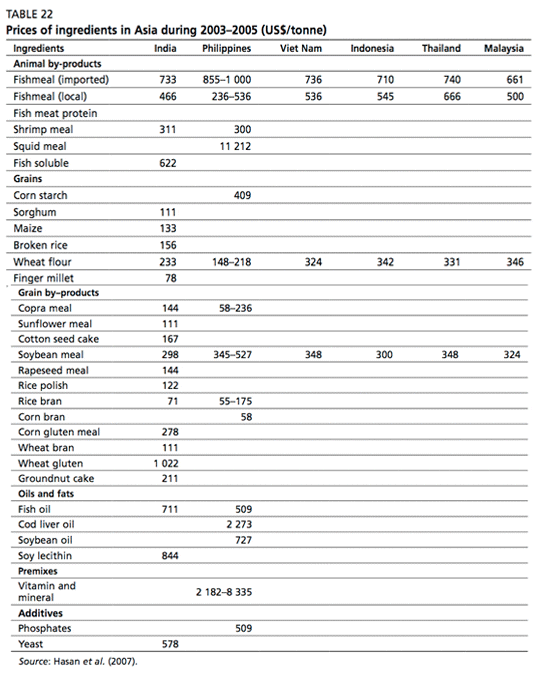
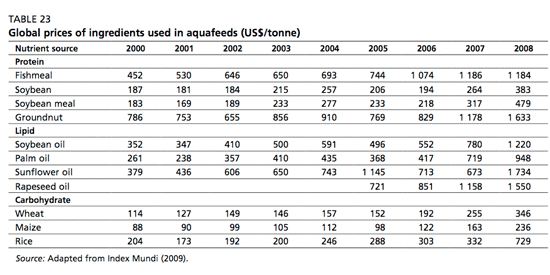
The decline in landings in Europe (Figure 16) and in South America have resulted in a sharp decline in fish supply. Overall, since 2003, global fishmeal supplies from the major producing countries in 2008 declined by 780 000 tonnes. This decline was sharpest in Europe. In Scandinavia, fishmeal availability declined from 504 000 tonnes in 2005 to 428 000 tonnes in 2008, while in South America fishmeal production declined from 2 million tonnes to 1.5 million tonnes in the same period. This production decline of suppliers combined with a sharp increase in imports by China led to escalating prices, which peaked at around US$1 300/tonne in mid-2006 (Figure 17). Prices have slipped to some extent since then, but still are around the US$1000 mark, about US$400 above 2003 prices. Currently, in 2009, prices are being checked by the global economic downturn and reduced demand for fishmeal from China, in particular.

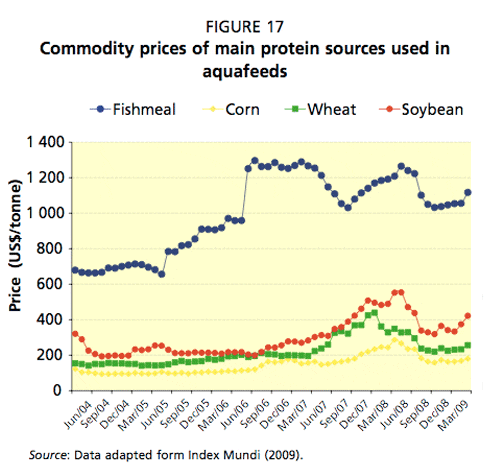
The supply of fish oil also principally reflects the catch quotas for fish species used for reduction to fishmeal. The quantity or yield of oil recovered is influenced by seasonality and species composition used. Fish oil production also declined in line with fishmeal production but the proportional decline was greater owing to varying oil yields. Supplies in 2008 declined by around 40 percent from around 650 000 tonnes in 2004 to 399 000 tonnes in 2008. Following record prices of nearly US$1 800/tonne in mid-June 2008, prices have sharply declined and fish oil is selling at less than half the price of US$850/tonne (Figure 18). The global economic downturn has also depressed the fish oil industry in 20082009. In addition, aquafeed producers are substituting more rapeseed oil for fish oil in their feed recipes, as the price of rapeseed began to fall. The high catch of mackerel in Iceland in late 2008 and the good yields of oil in the November 2008 fishing season in Peru, which increased inventories of fish oil, at a time of global economic downturn will most probably check price increase for fish oil.
Alternative proteins and oils used in aquafeeds
Significant progress has been made to reduce dependency on fishmeal and fish oil through the substitution of these marine raw ingredients with proteins and oils of land origin. As was the case for fishmeal and fish oil, the price increases of vegetable protein and oil mirrored those of marine ingredients, with sharp increases recorded in 2005 for soybean,
corn and wheat (Figure 17), and rapeseed, palm and soybean oils (Figure 18).
The price of corn, which has escalated from around US$100/tonne in 2004, peaked at around US$300 in June 2008 before falling to around US$180 in May 2009. The corn gluten, a protein concentrate (from the EU), used in high performance aquafeeds, however, increased from US$500/tonne in
2005 to over US$800/tonnes in November 2008. Similarly, soybean prices increased from US$200250/tonne in 2005 and peaked at US$550 in June 2008 before declining to US$330 in March 2009. The price of protein concentrate, however, is significantly higher, escalating from around US$450/tonne in the mid-2005 to a peak of US$950/tonne in June 2008
before dropping to US$800/tonne by the end of 2008.
The use of oils of plant origin as a substitute for fish oil has significantly increased and the prices of these substitutes have also risen sharply (Figure 19). Prices of palm, soybean and rapeseed oil have
gradually increased between 2004 and 2006, followed by a sharp increase in prices between 2007 and 2008 (Figure 18).
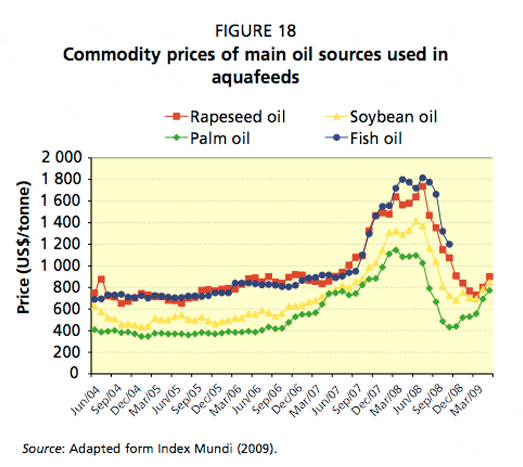
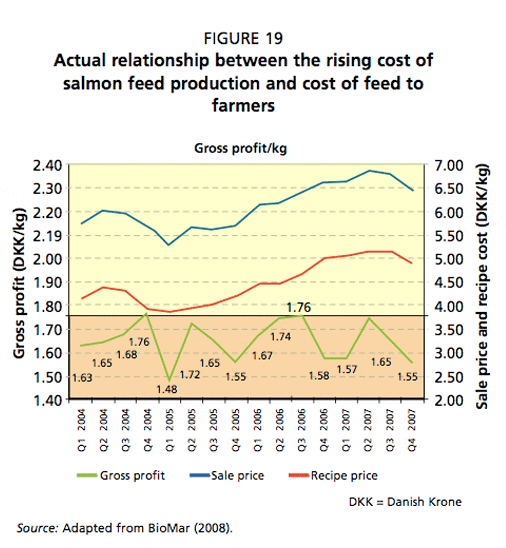
Rapeseed oil, which is the main substitute for fish oil in Europe, for example, increased from an average of US$720/tonne in 2005 to a peak of US$1 700/tonne in July 2008. Similarly, the price of palm oil used in Asia increased from US$375/tonne in 2005 to US$1 100/tonne in June 2008. Although prices have slipped since then, resurgence in demand in 2009 is forcing prices upwards again (Figure 18).
Impact of commodity prices on aquafeed costs and on farmersRising commodity, energy and fuel costs have resulted in significant increases in the prices of manufactured and on-farm aquafeeds in Europe and Asia. For salmon, the cost of raw materials accounts for 75 percent of production costs of formulated feeds and, therefore, the overall costs and escalation of commodity prices will have a notable impact on feed prices (see Box 3). In Europe, BioMar, the third largest salmonid diet manufacturer, passed on increased costs to farmers to secure profit margins. Between 2005 and 2007, the kilogram recipe costs of salmon diets increased by 25 percent (Figure 19). To secure the required gross profit margin of around 25 percent, the sale price (per kg diet) increased by a similar fraction (Figure 19). As these price increases are due to the increased price of traded commodities, such increases are likely to apply to other major feed manufacturers in Europe as well.
box 3The higher aquafeed costs have also affected farmers in Asia. In China, since early 2006, the price of shrimp feed has increased by US$143/tonne (RMB1 000) to US$1 060/ tonne (RMB7 400) after several rounds of price increases due to a large increase in the price of feed ingredients. However, considering the downturn of shrimp farming in 2008 and the limited capacity of shrimp farmers to bear further price increases, the shrimp feed price was only raised by RMB300 (US$43) per tonne. The difference between the production cost and price is borne by feed manufactures. In Viet Nam, farmers and feed producers in the Mekong (Cuu Long) delta region are facing serious losses as the price of fish feed continues to rocket. In 2009, the prices of basic ingredients increased by 30 percent, raising the cost of feed by VND13 000 13 500/kg. Rapeseed meal is a major raw material used in China as a protein substitute for fishmeal in aquafeeds and with its greater use in feeds, prices steadily increased. In 2003, prices were around RMB1 000/tonne. By April, 2009 prices almost doubled to RMB1 940/tonne.
Impact of rising fuel and energy costs on the cost of aquafeed ingredients
A schematic representation of the nodal points of impacts along the product chain affected by fuels price hikes is shown in Figure 20. The sharp increases in fuel prices have impacted significantly on the cost of securing the bulk ingredients used in aquafeeds and also affected the entire production chain. The high cost of fuel has impacted on fishing vessels that land fish for production and on transport of land-based ingredients used in aquafeeds. In addition, the higher fuel and energy costs have also reduced the profit margins of fish farmers, leading to farm closures and consolidation of the sector, especially in Europe.
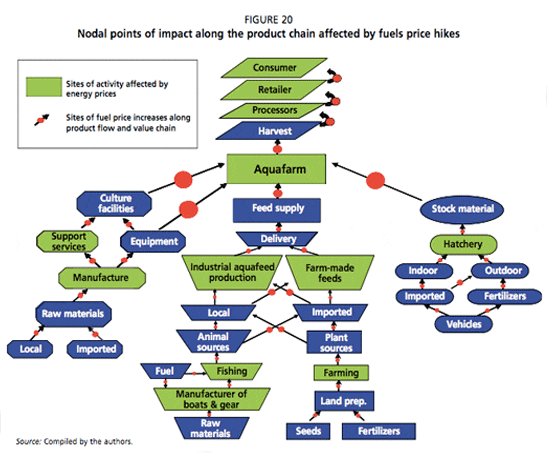
In Europe, the cost of fuel for fishing vessels has escalated dramatically. According to the EU Fisheries Commissioner, Joe Borg, the price of marine diesel has shot up 240 percent across Europe since 2004 (New Europe, 2008). Further, the European Association of Fish Producers reported a 320 percent increase in fuel prices over the last five years, and a 40 percent increase in fuel prices since January 2008. Similarly, in Latin America, the cost of fuel has skyrocketed. In Mexico, where fuel accounts for 60 percent of a vessels total operating costs, the cost of diesel fuel doubled from US$0.26 in 2006 to US$0.56 in 2008 (WW4 Report, 2008). Asian fishers, who supply a significant quantity of the trash fish used in aquafeeds, were also equally affected. In the Philippines, marine fuel prices increased by 50 percent between 2007 and 2008 from PHP40 to 60 (GMA News, 2008). In Viet Nam, the prices of diesel and kerosene went up by US$0.12 and UD$0.36 to UD$0.95 and UD$1.20, respectively (Asean Affairs, 2008), while in Indonesia, the government reduced subsidies and increased fuel prices by 29 percent overnight (Asia-Pacific News, 2008).
Types and Composition of Aquafeeds Used
In general, feeds and feeding practices vary according to the farming system, species under culture and stocking intensities. Traditional extensive farming systems, in which fish growth and production are dependent on consumption of natural food organisms in water, use no feed or fertilizer. In some cases, these systems use chemical fertilizers
and/or organic manures, which may also be added to stimulate and enhance natural productivity of pond water. In more intensively stocked farming systems, fertilizers and supplementary or complete feeds are used.
Feeds range from single component feeds available on-farm such as grass or rice bran to farm-made formulated feeds and commercial feeds. Feeds also can be simple farm- made moist or dry aquafeeds or formulated commercially made aquafeeds. However, there is no clear definition for what is farm-made and non-farm made aquafeed and non-farm made aquafeeds. FAO suggests that farm-made feeds be defined as feeds in
pellet or other forms, consisting of one or more artificial and/or natural feedstuffs, produced for the exclusive use of a particular farming activity and not for commercial sale or profit. Kitchen waste may also be considered as one of the types of farm-made aquafeed as per FAO definition as it contains one or more natural feedstuffs in non-
pellet form. De Silva and Hasan (2007) suggest that mixtures of ingredients subjected to some form of processing (simple mixing, grinding and cooking) done on-farm or in small processing plants are generally regarded as farm-made aquafeeds and are often the mainstay in small-scale semi-intensive aquaculture practices. Formulated commercial
feeds are composed of several ingredients, mixed in various proportions to complement each other, and form a nutritionally complete compounded diet. De Silva and Hasan (2007) categorized Asian aquafeeds into the following four groups.
- materials and/or ingredients of plant origin that are used singly or in combination with others (of plant or animal origin) but with little or no processing;
- materials of animal origin, primarily trash fish, that are used singly or in combination with others but with little or no processing;
- mixtures of ingredients that are subjected to some form of processing (simple grinding, mixing and cooking), resulting in a moist dough or in simple pellets;and
- feeds that are manufactured in industrial feed milling plants and are distributed and sold using conventional market chains.
A very wide range of ingredients is used to prepare farm-made aquafeeds. They include aquatic and terrestrial plants (duckweeds, Azolla, water hyacinth, etc.), aquatic animals (snails, clams, etc.) and terrestrial-based live feeds (silkworm larvae, maggots, etc.), plant processing products (de-oiled cakes and meals, beans, grains and brans) and animal-processing by-products (blood and feather meal, bone meal, etc.). Vegetable ingredients are used singly or in combination with other ingredients of plant or animal origin as feeds with no or little processing in small-scale aquaculture at the lower end of semi-intensive practices, while material of animal origin such as trash fish is used singly or in combination with other ingredients with no or little processing at the upper end of semi-intensive practices (De Silva and Hasan, 2007). Usually in intensive practices, commercial complete feeds are used.
Irrespective of the feed category, the majority of the ingredients used in the feeds, particularly in categories (iii) and (iv) above, are fairly common ingredients and include fishmeal, soybean meal, various oilseed cakes (De Silva and Hasan, 2007). According to the FAO (2008b), aquaculture used 56 percent (3 million tonnes) of world fishmeal
production in 2006 and 87 percent (800 000 tonnes) of fish oil production. Tacon (2008) puts this even higher, at 3.7 million tonnes of meal and 840 000 tonnes of oil. For Asia as a whole, the situation is further exacerbated as its contribution to the world supply of these three principal ingredients is minimal in comparison to the proportion that is used by the regional animal feed industry (De Silva and Hasan, 2007). For example, while Asia produces only 17 percent of the global fishmeal supply, it consumes 47 percent of it.
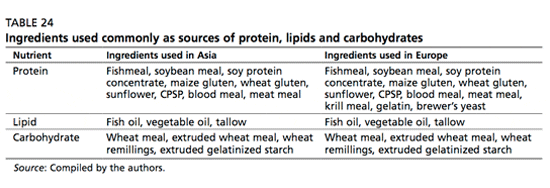
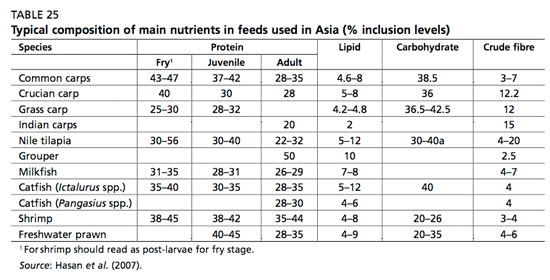
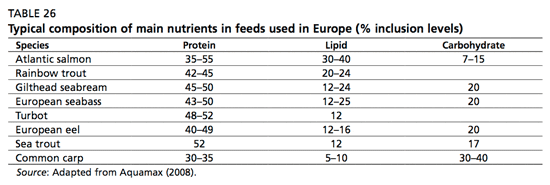
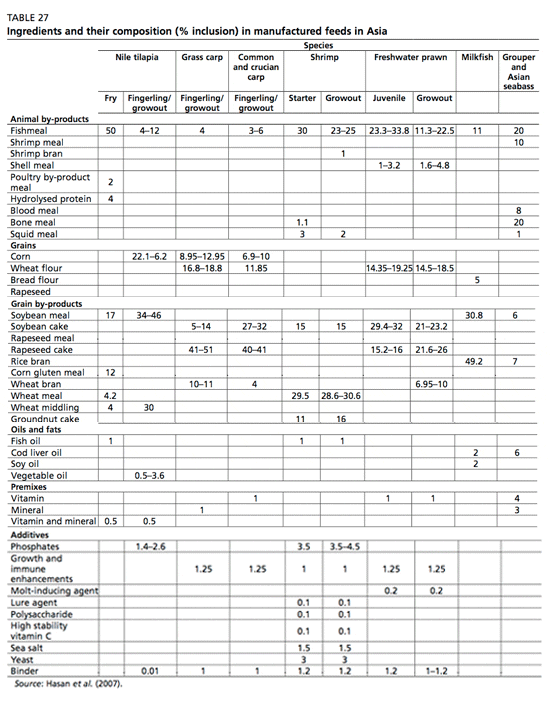
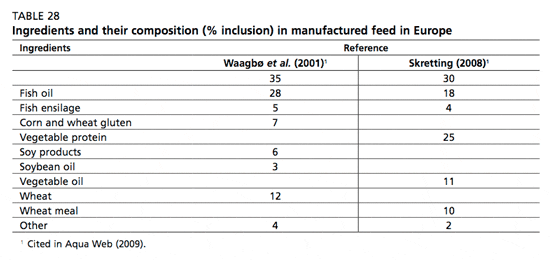
Ingredients commonly used as nutrient sources are given in Table 24. Species-specific composition of main nutrients used in formulated commercial fish feeds in Asia and in Europe are given in Tables 25 and 26. In terms of ingredients used in commercial aquafeeds, Asia and Europe do not differ much (Tables 27 and 28). Irrespective of the region, the commercial aquafeeds largely depend on soybean products and corn or wheat products. Additives are mainly used in high-value shrimp aquaculture in Asia. Apart from materials of animal and plant origin used as ingredients in aquafeeds, trash fish still remains the traditional feed for high-value marine carnivorous fish throughout the Asia-Pacific region and is likely to remain so for some time. They are currently an indispensable feed for carnivorous fish and are also used in farm-made feeds for omnivorous species in some countries such as China, Viet Nam and Indonesia. It has been estimated that Viet Nam uses nearly 900 000 tonnes of trash fish and China will require approximately 4 million tonnes of trash fish by 2013 to sustain marine cage culture activities (De Silva and Hasan, 2007). However, the depleting availability of trash fish is considered one of the most serious constraints for aquaculture development in Viet Nam. The supply of trash fish in Asia is highly seasonal and dwindling (Edwards, Tuan and Allan, 2004). Their efficacy as an aquafeed is debateable and their preferred use appears in many instances to be based more on farmer perceptions than economic reality (De Silva and Hasan, 2007). Moreover, the fishmeal manufactured mainly from trash fish, spoiled fish and processing waste is inferior in quality and often contains high levels of histamine and cadaverine substances (Hung and Huy, 2007). Dependency on trash fish may continue with the expansion of marine cage aquaculture despite the socio-economic and environmental consequences of using trash fish and feed. However, because of the negative consequences for sustainability of the use of trash fish in terms of:
- the impact on near-shore fishery stocks;
- damage to the coastal environment;
- their potential to introduce disease in the cultured fish; (iv) inconsistent and inferior quality; and
- depleting availability, the growth of high-value marine carnivores will have to depend on commercial complete feeds sooner rather than later.
Positioning of the Industry to Meet the Challenge of Securing Aquafeed to Sustain Aquaculture
Search for substitution of fishmeal and fish oil due to rising prices and availability
Fishmeal and fish oil are highly favoured ingredients in aquafeeds for a number of reasons, including:
- high protein, essential amino acids, mineral and essential fatty acids;
- high palatability and digestibility, thus increased growth of fish and less feed wastage; and
- health benefits such as improved immunity, survival rate and reduced incidences of deformities.
Fishmeal production is constrained by its dependency on a finite resource, viz, pelagic fish, the stocks of which are declining due to the cyclic El Nio effect, and the likely continuation of high prices. Landings of small pelagic fish for fishmeal production in South America, which produces around 40 percent of the worlds fishmeal and fish oil, were very low in the first quarter of 2007, some 20 percent below
the previous year and around 14 percent below the five-year average (Globefish, 2007). Apart from high prices, the aquaculture industry is in competition for fishmeal, because fishmeal is used for animal production and is a primary protein source in the diets of cattle, poultry and pigs. In real terms, world poultry and pig meat production
increased from 76 million tonnes and 96 million tonnes in 2003, respectively, (FAO, 2004) to 83.7 million tonnes and 106.9 million tonnes in 2006, respectively, (FAO, 2007). Although current annual growth of poultry and pig meat production is not as high as that in aquaculture, higher protein percentages (15 percent to 20 percent) are
used and absolute production levels in poultry and pig meat industries, lack of fishmeal availability may be of serious concern for fish-feed development. For Asia as a whole, the situation is further exacerbated as its contribution to the world supply of these principal ingredients is minimal in comparison with the proportion that is used by the regional animal feed industry (De Silva and Hasan, 2007). For example, while Asia produces only 17 percent, it consumes 47 percent of the global fishmeal supply.
A closer look at how the trade-offs are likely to take place in future between the main types of aquaculture will provide a clear insight into the danger of dependency on fishmeal for fish feeds. Within the aquaculture sector, the main consumers of fishmeal are shrimp (22.8 percent), marine fish (20.1 percent), salmonids (19.5 percent) and carps (14.9 percent) (Tacon, 2005). Increase in fishmeal and fish oil production to meet the demand of the aquaculture and livestock industries is very unlikely as the landings of the capture fisheries of forage fish, which are reduced to fishmeal and fish oil, are on the decline. Because the emphasis is on the high-value marine species and intensification of carp culture, dependency on fishmeal will be risky and the competition between livestock producers and aquaculturists could be more severe if an alternate to fishmeal is not found. Moreover, if aquaculture sustains its current growth rate, potentially all fishmeal and fish oil would be utilized by 2020 and 2010, respectively (Tacon, 2005), and finding suitable alternatives to fishmeal and fish oil that are sustainable, as well as improving feeding practices, would be a practical solution.
In the search for viable alternative feedstuffs to fishmeal for aquafeeds, candidate ingredients must possess certain characteristics, including wide availability, competitive price, as well as ease of handling, shipping, storage and use in feed production (Gatlin et al., 2007). The main challenge in replacing fishmeal and fish oil is to find alternatives that maintain acceptable growth rates, animal health and changes to the final product (Tacon, Hasan and Subasinghe, 2006). Further, they must possess certain nutritional characteristics, such as low levels of fibre, starch, especially non-soluble carbohydrates, and anti-nutrients, and have relatively high protein content, favourable amino acid profile, high nutrient digestibility, and reasonable palatability (Gatlin et al., 2007). There is an increasing trend towards replacing fishmeal with alternate protein sources, particularly plant material (Table 29), which are believed to be in abundance at a reasonable price when compared with fishmeal, which is costly due to the dwindling supply and erratic price.
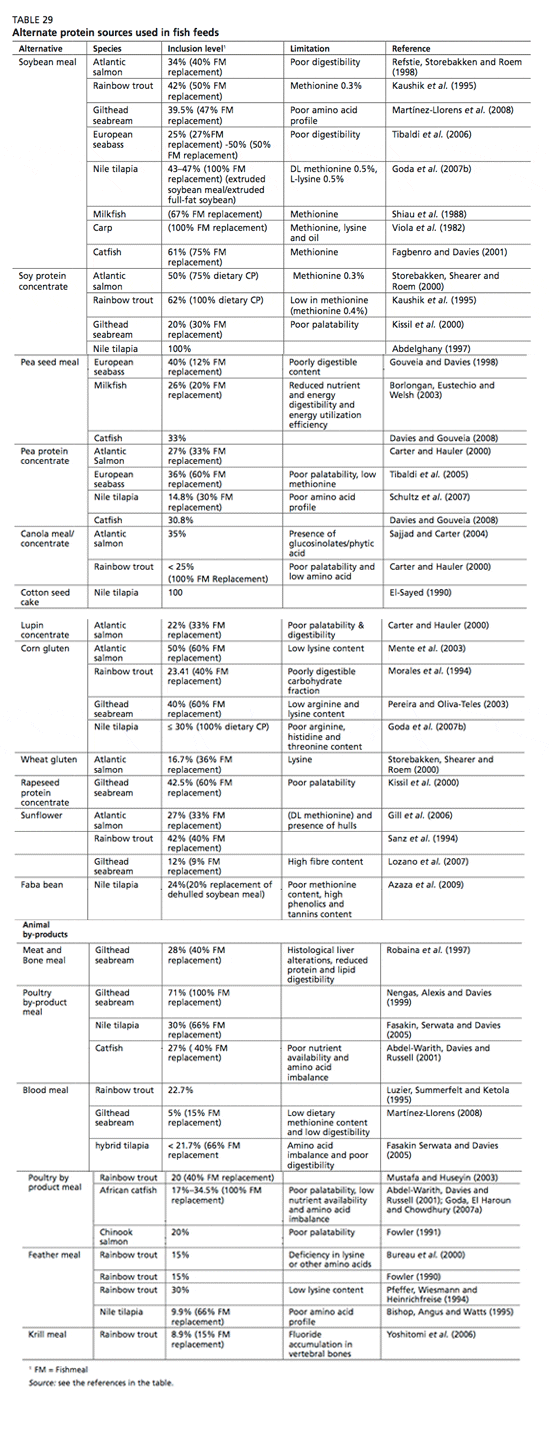
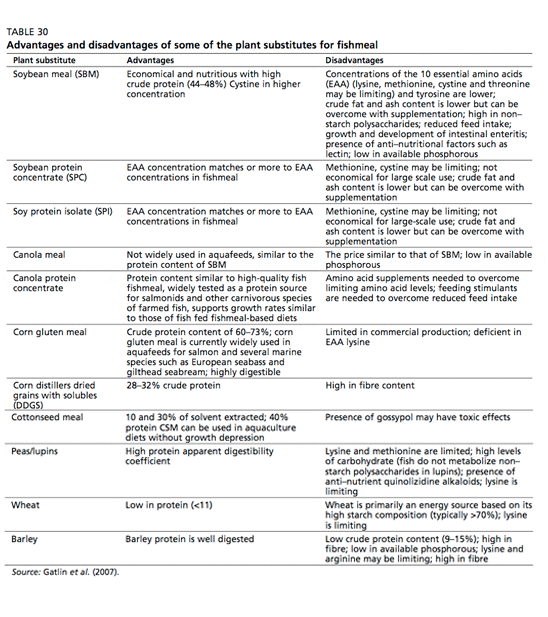
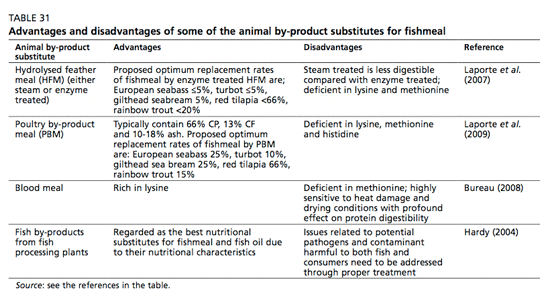
The plant materials and animal by-products used in fish feeds as substitutes for fishmeal, and their advantages and disadvantages are summarized in Tables 30 and 31.

